Spears of Joseph A. Rony the Elder and Gene M. Auell (part 1)
Well, what are the most ancient spears? Of course, the stone age! We were told about this even in the 5 high school class and, in general, they were speaking correctly, but by and large this is about nothing. The Stone Age was the longest milestone in stories of humanity. It was then that there existed various subspecies of Homo sapiens, and is it not interesting to try to find out exactly where, and from whom, these very spears appeared at that time far from us. After all, a spear was one of the steps to the heights of civilization, just like a harpoon, a drilled ax, a raft, a sail, a wheel, and so on ...
Paleolithic hunter with the most ancient form of a spear, whose wooden point was burned in the fire flame. Archaeological Museum, Bonn
Probably, many of you read the novel “The Fight for Fire” by French writer Joseph A. Rony, written back in 1909 on the basis of the then knowledge about the life of primitive people. This is a fascinating story about the search for fire, without which the tribe of ulamrs (obviously people of the modern kind) cannot exist. In 1981, he was screened, and the quality of the film version is indicated by the fact that this film was given two awards: “Cesar” and “Oscar”. Although I personally am not delighted with him. And there are a lot of blunders in it, and the plot is too simplistic compared to the novel.
The film "The Last Neanderthal" (2010). A "stick" could take and straighter!
It is important to note that in other novels J.I. Roni on the “primitive theme”, such as “Virareh” (1892), “Cave Lion” (1918) and “Eldar from the Blue River” (1929). The main theme of the narrative is the merciless clash of primitive human races in the fight for fire or - for women, or simply because “aliens are enemies”.
In this case, the characters enjoy a solid arsenal weaponswhich they constantly carry with them. These are spears with flint tips, and spears are apparently the same spears, but with a crosshair on a pole, so that the tip does not enter the body of the enemy very deeply. In any case, this was precisely the device of the hunting rat in the Middle Ages, but the French writer does not provide any details of its device. Then his heroes use darts, stone axes, and the strongest of them use clubs - a solid weight with battle clubs from the butt of young oak trees, burned for strength on fire.
It is interesting that the tribes described in the novels of the French writer, although they exist in the same time and space, are at different levels of development, which, however, can be explained by their belonging to different human types. Naturally, this is reflected in their armament. For example, the more “advanced” people from the Wa tribe already use a stick-spear, while all the others are more backward, they do not yet have these weapons! This, in general, a simple weapon, as a sling is not used and not even mentioned. That is, the author, most likely, believed that it was invented by man later.
"A man with a spear." Petroglyph from Sweden.
But nowadays American American Gene M. Auele wrote a series of novels, the main character of which was made by primitive girl Aila. It is important to note that Jean Auel was at the excavations in France, Austria, Czechoslovakia, Ukraine, Hungary and Germany, and was engaged in popular servileing these days: she learned how to make stone tools, build houses from snow, to work deer skins and weave grass mats . In the process of working on novels, she consulted with anthropologists, archeologists, historians, ethnographers and specialists in other fields of knowledge, in order to show the world of the Late Pleistocene, in which her characters lived and acted as plausibly as possible, and she fully succeeded.
But the point of view on the coexistence of primitive races is not at all the same as in the novels of Roni the Elder. Despite all the interspecific differences, primitive people do not quarrel with her, and there are practically no descriptions of bloody fights between them in her novels. Weapons are used only against animals! The attack of a person on a person is a rarity and a lot of completely asocial types condemned by all tribes.
As for the actual arsenal of its heroes, it may not be as diverse as in the novels of the French writer, but then it is more effective. This bola is a few stones with a tail of tails, tied with a rope, tossing which, the hunter could tangle the legs of the long-legged prey; sling, which Gene and Auele use both men and women. Another weapon that the heroine invents and puts into use in the novel is precisely the stick spear, the use of which made it possible to throw light darts and spears much further than can be done with a hand. And - yes, indeed, there is evidence that this weapon was used already in the Late Paleolithic. Later, the spear was spread among the aborigines of Australia, in whom it is known as Woomera, Wommera, Wammera, Amer, Purtanji, in New Guinea and near the coastal peoples of northeast Asia and North America, and even in Sakhalin near the Nivkhs. The Spaniards met with a spear thrower, which the aborigines called atlatl, during the conquest of Mexico). Usually it was a plate with an emphasis on one end and two hooks for fingers or a handle on the other, that is, it was arranged very, very simply.

A stone-tipped spear from Cabo Verde National Park.
But for us it is important in this case, what information about all this is given to us by the drawings on the walls of the Paleolithic caves, which are the most real galleries of primitive painting. If we take into account the particular nature of one image or another according to the principle, “what is most important for me, then I draw”, then we can conclude that most of the time primitive people were engaged in earning themselves. No wonder there are so many drawings with scenes of hunting in these caves. Thus, in the cave of Lascaux in France found drawings of animals, pierced by a set of darts; and next to it are conventional images of lancetals, which makes it possible to conclude that all these types of weapons at that time already existed and were used. In the center of this cave, in the so-called apse, in a deep four-meter well one can see a colorful image of a bison struck by a large spear; he has a stomach open and fallen entrails are visible. Next to him lies a man, near whom lies a piece of a spear and a small rod decorated with a schematic depiction of a bird. It is very similar to the horn spear from the Mas d'Azille cave in the Pyrenees, belonging to the so-called Azilian culture, with the image of a snow grouse near the hook, so that we see that ancient people even decorated this weapon! Moreover, this find is by no means an exception. But at the gunman, found in the parking lot of Abri Montastruk, also on the territory of modern France and made of deer horn about 12 thousands of years ago, this hook was made in the form of a jumping horse, so the tendency here is clearly defined - “the arms should be decorated”!
By this time, namely in the era of the late Paleolithic, the time of man of the modern species ended, the time of mass hunting for large animals came with the development of strong social ties and internal laws of life that followed, and also the extraordinary flourishing of art that reached the highest level 15 - 10 thousand . years BC. er By this time, the technique of manufacturing tools and weapons has become truly masterly. In any case, today, according to archaeological finds, we know about 150 types of stone and 20 types of bone tools of this time. That's just a pity that only some of them were depicted by ancient people on the walls of these caves, so unfortunately these pictures will not tell us much. Animals - oh yeah, Paleolithic people portrayed very often! But themselves and everyday objects - alas, no, and why it is still unknown so far, although there are no numbers explaining the ingenious hypotheses.
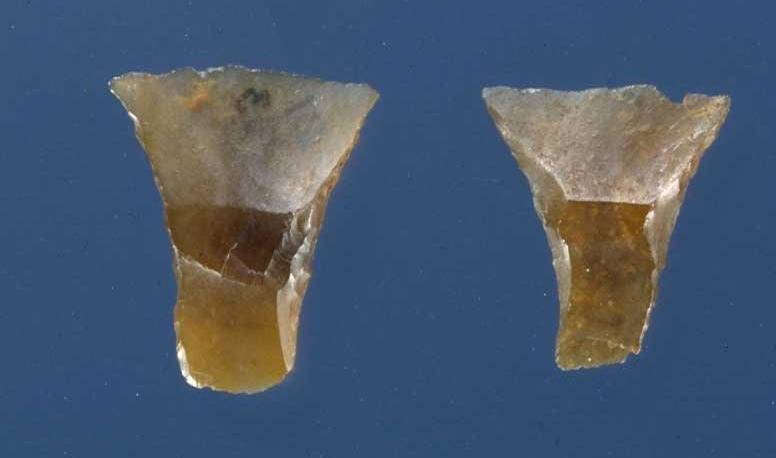
And this arrowheads! And chopping, and not pointed. Amazing isn't it? Metal tips of this form are known, but it turns out they were the same and stone!
That is, in this case, the images are very much under-negotiated, and in order to explain them we will have to compare them with the artifacts of that time discovered by archaeologists. However, we will begin again, not with the findings as such, but with the fact that we again turn to the novels of J.Rony the Sr. and Jean Auel. Why in the works of the first ancient people all the time hostile, while the "children of the Earth" have Auel prefer to still negotiate? Most likely, it’s about the specifics of her current worldview, which was brought back thousands of years ago. As far as all this is “not so”, archaeological finds show. For example, even when the archeologist Arthur Leakey discovered an ancient man’s skull pierced by a sharp stone in the Olduvai Gorge in Kenya, it was already possible to assume that there was no “world under the olive trees” even in that distant era. And it was clear that a roughly crushed stone in a man’s hand (according to various estimates, it could be from 800 thousand to 400 thousand years) could be both a hammer, a chisel, and a scraper, and ... a sufficiently effective weapon.
Apparently, the entire history of humanity J.Roni Sr. saw as one continuous confrontation between people of different physical types, who in the same novel “The Fight for Fire” represent the ulamras, kzamy, red dwarfs and people of the Ba tribe. But wasn’t it all reflected in various artifacts and talentedly conveyed in artistic images? Almost all the epic heroes, to whatever people they belong to, constantly cling to the enemies, embodying "absolute evil." At the same time, it is interesting that most of the heroes, in any case, the most famous among them, are concerned with the problem of their own immortality or invulnerability, or their parents or friends take care of it. The hero of the Iliad, Achilles, is invulnerable to his mother, the goddess who bathes him in the waters of the underground river Styx. Siegfried - the character of the Song of the Nibelungs is bathed in dragon's blood for the same purpose. Exiled hero - the hero of the epic of the narts becomes invulnerable after his father, the blacksmith, places him again in infancy in a red-hot furnace, and holds him with his tongs for legs below the knees. But it is interesting that even then people were wise enough to understand: it is impossible to get absolute invulnerability! The same goddess Thetis holds Achilles by the heel, and it is the arrow of the cunning Paris that falls into it. A leaf of wood stuck to Siegfried's back, and the spear of his enemy stuck it. Well, and the magic wheel Balsaga, who recognized his secret, acts as a cunning ruin of Soslan. After waiting for him to fall asleep, the wheel rolled over his vulnerable spot and ... cut off both his legs below the knees, causing him to bleed out!
That is where the desire of the later knights comes from to put on armor impenetrable for every weapon - from our legendary past! However, the main means of protection for a stone-age man was by no means armor, which, of course, he did not know then, but ... the distance that prevented the enemy from approaching his victim and delivering a fatal blow. We know from the Bible that Cain rebelled against Abel and killed him, but neither the method of murder nor the distance between the criminal and the victim at the time of his commission is specified. Nevertheless, it can be assumed that it was small and Cain either strangled Abel, killed him with a shepherd's staff, or stabbed him with an ordinary knife. The stone that he picked up from the ground and hit his victim on the head is not excluded. In any case, this would not have happened if Abel had managed to escape from him. So frisky legs were just as important a means of protection as were armor and shields.
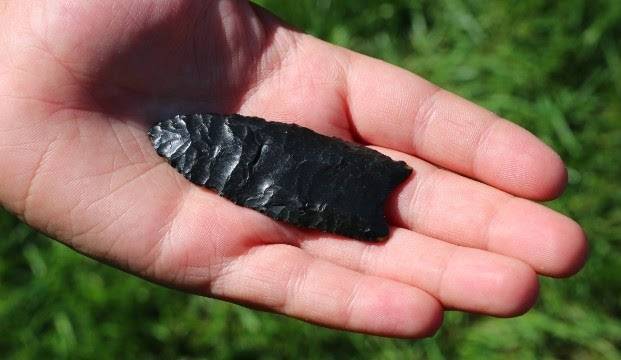
This tip was recently found by a boy in Texas ...
The distance between opponents could be overcome with the help of appropriate throwing weapons: stones and throwing copies. It is known that, for example, the Japanese infantrymen to ashigaru had spears up to 6,5 meters long. That is, it was the maximum combat distance at which one soldier could lead a battle with another without holding his weapon out of his hands, while the bow allowed one person to hit another at a distance of several dozen or even hundreds of meters, not to mention the reach of an individual and collective firearm. weapons. And for the latter, even 100 kilometers is not the limit! Thus, it is obvious that the whole history of the armed struggle of people against each other (not to mention hunting for the sake of their food!) Was reduced to the creation of effective means of attack, extending their arms and legs and developing appropriate means of protection against the enemy.
But when did people come up with the idea of creating the first samples of throwing weapons with stone tips? It is clear that they themselves, most likely, threw stones at the target always, however, how can you determine whether a particular stone was thrown at the target or whether it just cracked from time to time. After all, the fingerprints have not been preserved on the stones since ... And when did the ancient people come up with precisely the throwing, not the impact spears described by Neanderthals in Jean Auel's novels?
To be continued ...
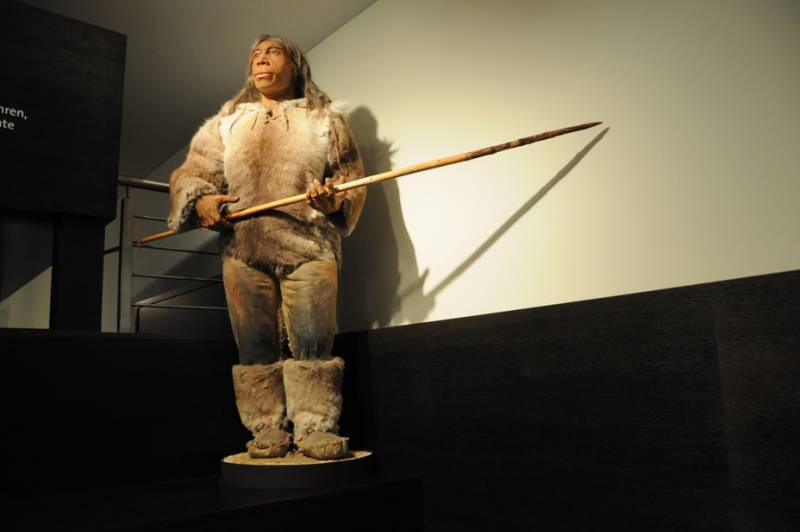
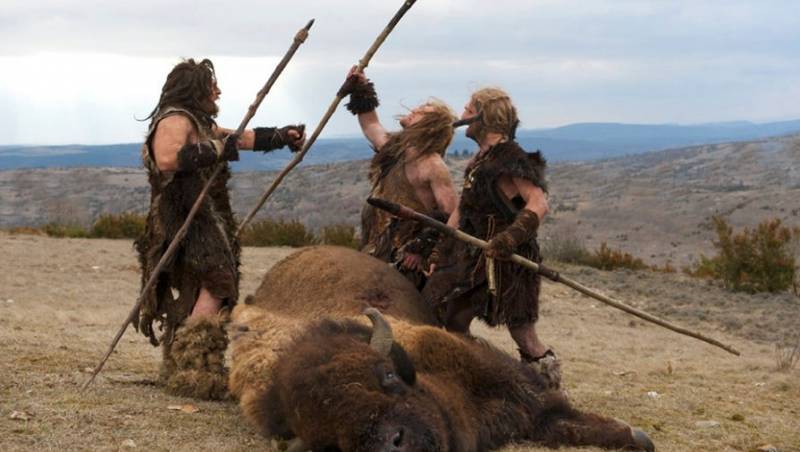
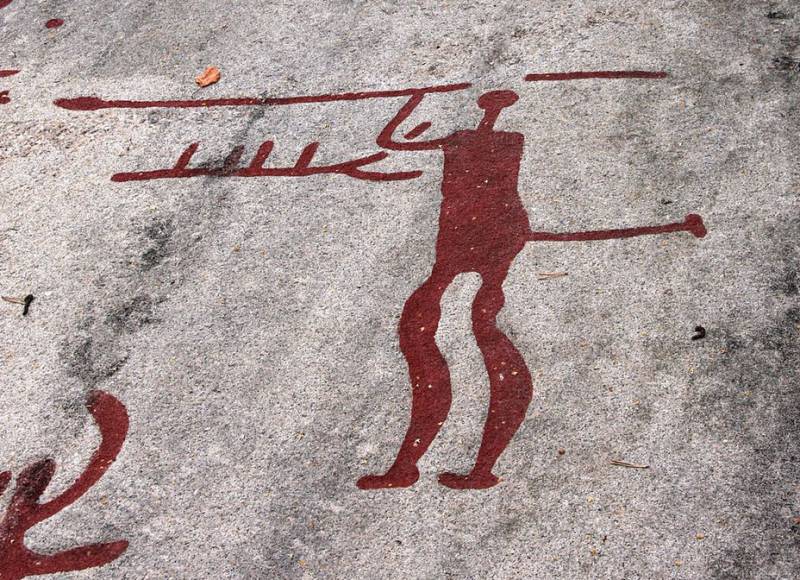
Information